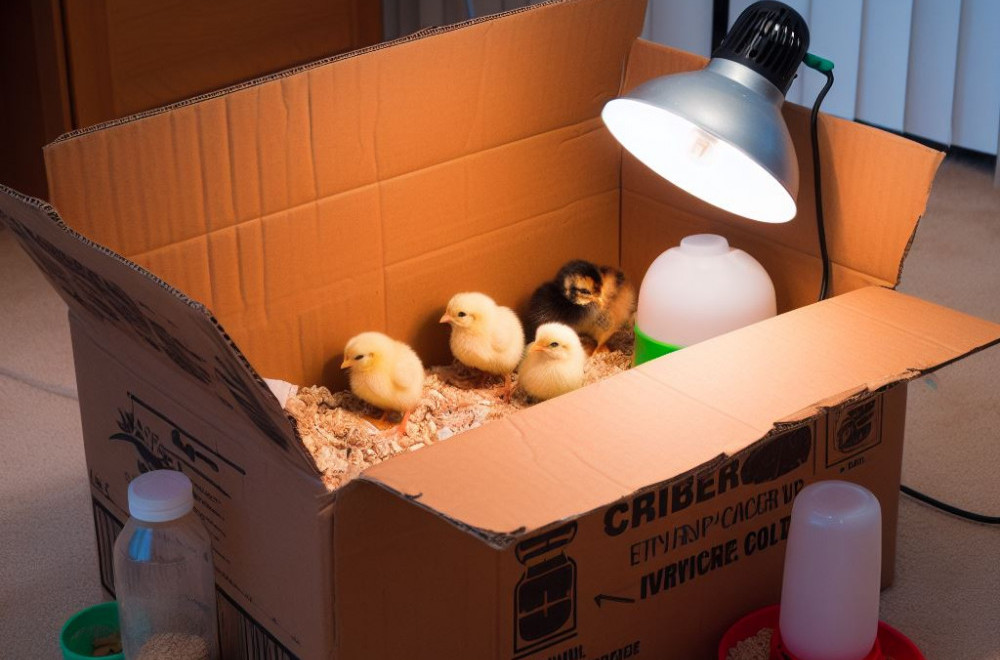The joy of buying baby chicks is the same type of joy that a kid feels when opening birthday presents. Usually, though, it is an impulsive buy that doesn’t take in the ramifications of the action. That’s when you need home chick brooder ideas to rescue you.

Hey, don’t worry… I’ve done it many times. I go to the farm supply store in the spring, and the baby chicks just pull me in every time. I want to buy them all, but usually wind up with a dozen or so. Then… I have to figure out where to put them all.
Is it important to have a brooder? Yes, it is. Providing proper care for unplanned baby chicks while young will lead them to a healthy and productive life.
One of the most important things to remember is that the choice of a brooder must be right for your new flock’s size.
What is a Brooder?
- A brooder is the chick’s first home. It is where the little ones will spend the first several weeks of their lives.
- Essential components include a heat source, bedding, safety, and space for food and water.
Chicks hatch out of the egg, all wet and not so sure-footed. After drying and resting for a while, they become the cute, fluffy little bundles of joy we all love watching and holding. They are so tiny and fragile.

To keep them warm, comfortable, safe, and well-satisfied, the brooder is their fortress against a world of giants and obstacles that can bring them harm.
Why Consider Homemade Brooders?
So, you’ve brought your baby chicks home and have to figure out where to put them. You didn’t give much thought to the fact that they need to be housed properly. All you know is that you HAD to have them!
The advantage of repurposing household items becomes apparent.
Cost-effectiveness and customization are on the menu of tasks at hand to create the perfect temporary quarters for your new family members.
8 DIY Brooder Ideas
You already have do-it-yourself brooders around the house, shed, or barn. They can be made of cardboard, wood, plastic, metal, and even haybales in a pinch.
The beauty of DIY projects is in the savings you don’t have to expend and the creativity you get to exercise. Let’s start with cardboard.
A Cardboard Box
Pros: Quick setup and easy availability. Customization is a breeze with a sharp knife, scissors, or a utility blade. (Parental supervision is a must, of course).
Windows and doors can be easily cut in. In the end, the brooder can be thrown out with the trash.
The box size can be increased to accommodate more chicks — think refrigerator box.
Cons: Cardboard can get wet easily and is flammable. If you go with a cardboard box, be sure to be careful with heat lamp placement. Placing the waterer on a large plate can greatly help with spilled water.

Metal Wash Tub
Pros: Extremely durable, easy to clean, non-flammable. It’s small enough to hang on the wall when done. It’s a multi-purpose container.
Cons: Limited space for growing chicks. Metal conducts cold readily. It’s not easy to customize.
Any metal washtub that is easily moved will not be large enough to hold more than a half-dozen chicks or so. Remember that chicks grow quickly, so the size of their living area also shrinks quickly.

Plastic Storage Tote
Pros: Probably more spacious than a metal tub, resistant to moisture, and customizable.
Adding a tunnel to another space, adding a window, or any other feature is easy with a plastic tub,

My most recent brooder was a 40-gallon plastic tub from Tractor Supply. As you can see, there is plenty of room for eight chicks or so.
The tubs are clean and light. I customized this later on to allow the chicks into a dog crate. I spoil my chicks with too much freedom. Don’t hate me.
Cons – Space is somewhat limited.
Dog Crate/Rabbit or Bird Cage

Pros: Readily available, versatile.
Modify for chick safety. As you can see, I had to tape around the bottom of this dog cage so the little ones couldn’t escape into the room and destroy it.
One of the best features of the cage is a field of vision. The chicks don’t have to stare at blank walls all day. They can see the world into which they will enter soon.
Cons: Some cages have walls where baby chicks can get through or, worse, trapped. Be careful to get enough small mesh or bars to contain the chicks.
Puppy/Baby Gates

Pros: Can create a large brooding area.
Cons: Like cages, openings in baby or pet gates must be closed up with some material to keep the chicks from escaping. Getting several of these to build the size you desire could be expensive.
Chicken wire fence comes in many heights, so getting the right height to customize the outside of a pen made with baby gates is very doable.
Horse Trough or Stock Tank

Pros:
Large, easy to clean.
– Tips: Using a cover for chick safety.
Cons: Heavy. Once in place, it is not easy to move around. Not easily customizable.
Puppy Playpen
Pros: Spacious, easy to clean, suitable for larger chick groups.
Cons: Be careful with your heat source. The better choice for this brooder is an infrared heatplate. They can be found just about anywhere chicken supplies are sold.
This is an excellent option because it is easy to set up, it keeps chicks well contained, and it allows them to see what’s going on in the outside world, making them less nervous around people and pets.
Finally, we have the old bathtub that happens to be lying around. How does that even happen? I don’t know, but it does!
Bathtub
Pros: Great for ducklings, easy cleanup.
Cons: Bulky and hard to move. Not easily customizable.
Additional Tips for a Successful Brooder
- Monitoring and adjusting the temperature. Your brooder needs to be warm. Chicks are happy at 95 degrees Fahrenheit; you can drop the temperature five degrees a week until you reach 70 degrees. That should put you around week five. At week six, your chicks are ready to move on to their semipermanent or permanent home in the coop.
- Choosing the right chick feed: Medicated vs. Non-Medicated. You won’t need medicated feed if your chicks are vaccinated against coccidiosis. If a nonmedicated feed is used, make sure to keep the brooder extra clean as a precaution against the disease.
- Importance of clean water and proper waterer selection. Newly hatched chicks should be introduced to water at room temperature as cold water can shock them, causing serious health issues. Put pebbles or marbles in the water to keep chicks from drowning.
- Bedding options and their pros and cons. Course wood shavings are okay for chicks, but a towel is not a bad choice since it is easier to navigate and provides sure footing. The newspaper has ink in it—yuck! A bare floor is not a good choice because it is slippery.
Ahh… Baby Chicks!
The joy of raising chicks is one of the reasons that we raise chickens, is it not? Watching them race around for no apparent reason and responding to our attention is a heartwarming experience.
The chicken’s role in homesteading is huge indeed. As a source of continuous food in the form of eggs, a renewable resource in terms of the ability to constantly refresh the flock with new members, and hearty chicken stew when the laying is over, makes chickens the best resource a homesteader could have.
And let us not forget all of the benefits of chicken manure as fertilizer and “green” material for compost.
I encourage you to explore and experiment with different brooder ideas. I’m sure you have something around the house or shed that would work just fine.
What’s Your Story?
Do you already have your own DIY brooder experiences?
We’d love to hear about them in the comments below. C’mon… you must have a tractor tire story to share with us.
Thanks a lot for stopping by. I really appreciate your readership and your comments. Take care. See you soon.
Dave
Chickenmethod.com

